Search the Blog
Categories
- Books & Reading
- Broadband Buzz
- Census
- Education & Training
- Friday Reads
- General
- Grants
- Information Resources
- Library Management
- Nebraska Center for the Book
- Nebraska Libraries on the Web
- Nebraska Memories
- Now hiring @ your library
- Preservation
- Pretty Sweet Tech
- Programming
- Public Library Boards of Trustees
- Public Relations
- Talking Book & Braille Service (TBBS)
- Technology
- Uncategorized
- What's Up Doc / Govdocs
- Youth Services
Archives
Subscribe
Tag Archives: Friday Reads
Friday Reads: The Care and Management of Lies, by Jacqueline Winspear
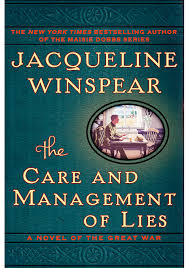 Also set in World War I, this book is written from a different perspective than the book Mary Jo wrote about two weeks ago. The story opens in England on a hopeful note with Kezia Marchant preparing for her wedding to Tom Brissenden just weeks before war is declared. It is a poignant story of love, friendships, changing relationships, differing philosophies, duty, sacrifice, and bravery. The lies of the title include those in the letters Tom writes from the trenches to limit Kezia’s concerns, and Kezia’s unique stories in return of the delicious meals she dreams up to serve him instead of worrying him about changes on their farm. Other characters lie to themselves or live lies to justify their actions and beliefs. This story provides a very human look at how the stresses of war can affect individuals, families, friends, communities and cultures.
Also set in World War I, this book is written from a different perspective than the book Mary Jo wrote about two weeks ago. The story opens in England on a hopeful note with Kezia Marchant preparing for her wedding to Tom Brissenden just weeks before war is declared. It is a poignant story of love, friendships, changing relationships, differing philosophies, duty, sacrifice, and bravery. The lies of the title include those in the letters Tom writes from the trenches to limit Kezia’s concerns, and Kezia’s unique stories in return of the delicious meals she dreams up to serve him instead of worrying him about changes on their farm. Other characters lie to themselves or live lies to justify their actions and beliefs. This story provides a very human look at how the stresses of war can affect individuals, families, friends, communities and cultures.
This is a standalone book, but Jacqueline Winspear also writes the Maisie Dobbs series set in England after World War I.
Friday Reads: Stubby the War Dog by Ann Bausum
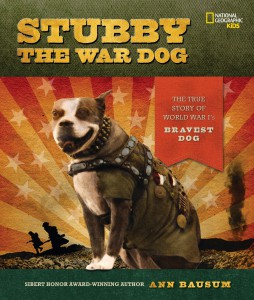 I have been reading books for preschool through high school ages preparing for next year’s summer reading program “Every Hero Has a Story.” Among my favorites so far is a nonfiction title: Stubby the War Dog by Ann Bausum, written for grades 4-7. Stubby was a stray who connected with J. Robert Conroy, an enlisted man among many who were training on Yale’s athletic grounds in 1917. When the time came to ship out, Stubby was smuggled on board and soon was considered by all to be a part of the unit.
I have been reading books for preschool through high school ages preparing for next year’s summer reading program “Every Hero Has a Story.” Among my favorites so far is a nonfiction title: Stubby the War Dog by Ann Bausum, written for grades 4-7. Stubby was a stray who connected with J. Robert Conroy, an enlisted man among many who were training on Yale’s athletic grounds in 1917. When the time came to ship out, Stubby was smuggled on board and soon was considered by all to be a part of the unit.
He brought companionship and relieved tedium, but also helped his fellow soldiers by killing rats in the trenches, warning them of imminent gas attacks, and even captured a German soldier on his own.
Period photographs of Stubby and of the countryside at that time help to bring his story to life. And just so you know, Stubby made it back home, and so did his best buddy Conroy.
Friday Reads: Johnny Got His Gun, by Dalton Trumbo
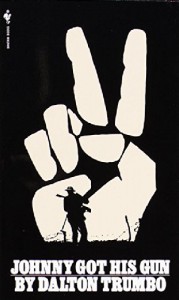 At the risk of appearing like military-themed books are the only books that Nebraska Library Commission staff read during the summer, I’ve chosen a book that epitomizes this 100th anniversary of the start of World War I—for me. We always talk about books that change our lives and we know that different books can have a huge impact on our lives, sometimes depending on our life-stage and the environment. This is a book that stopped me in my tracks, and continues to this day to influence my ethical perspective and world view.
At the risk of appearing like military-themed books are the only books that Nebraska Library Commission staff read during the summer, I’ve chosen a book that epitomizes this 100th anniversary of the start of World War I—for me. We always talk about books that change our lives and we know that different books can have a huge impact on our lives, sometimes depending on our life-stage and the environment. This is a book that stopped me in my tracks, and continues to this day to influence my ethical perspective and world view.
Written in 1938 by Dalton Trumbo, I came across Johnny Got His Gun as a student in a UNL English Literature class in the winter of 1970. It was among dozens of books we were assigned to read, but it is the only one I remember. This book sparked some of the liveliest discussions of my educational career, outside of discussing our original poetry in Ted Kooser’s Poetry Writing class—nothing gets the conversation heated up more than criticizing a classmate’s heartfelt, original works of poetry.
The book begins as a stream-of-consciousness, first-person narration by a severely wounded American soldier, Joe Bonham. Joe slowly comes to realize the extent of his injuries, as the reader gets to know Joe through his richly detailed memories of life before and during the war. The reader shares Joe’s growing horror as he begins to comprehend the loss of his senses one-by-one, interspersed with memories of how those senses gave him a rich full life and made him the man he was: touching, hearing, tasting, seeing, smelling (“There was a smell about the fair grounds you never forgot. A smell you never ceased dreaming of. He would always smell it somewhere back in his mind as long as he lived.”). Joe’s mind is still sharp as he struggles with existential issues: Is he awake or asleep? Is he dreaming or day-dreaming? Can he think his way out of this mess his life has become? What is the “future” for him?
The reader comes to realize the brutal horrors of war as they impact a very real person. Besides being a skillfully crafted story, the characters are so engaging and the depiction of time and place so perfect that reading this book really is like watching a movie. And no matter how badly I wanted to turn my eyes away, it was impossible to stop reading because Joe’s personality and predicament just got under my skin.
“And we won’t be back ‘till it’s over, over there,” went the words to a popular song used to recruit so many young people. But the reality is—it’s never over, over there—or over here. If the past one hundred years haven’t proved that, I don’t know what will. This war was romanticized beyond belief. The propaganda posters that drew so many to their death illustrate that target marketing was used to convince young people that their way of life depended on their participation in this “war to end all wars.” It’s a real education to take a look at examples of WW I posters at www.loc.gov/pictures/collection/wwipos/ and then contrast them to those of the Vietnam War era at http://www.theatlantic.com/national/archive/2011/08/protest-posters-from-the-vietnam-era/243029/#slide2. 
For many of us in that English class in 1970, the comparison of the Vietnam War to WWI seemed inevitable. As we discussed this book we railed against the war that was killing our friends and former classmates—sitting in our comfortable seats in Andrews Hall, smoking cigarettes, and arguing about making the world safe for democracy. Even though the reality is that these two wars were very different—WWI was the war that introduced us to modern, efficient killing machines and chemicals—there were enough similarities to feed the dissidence that was already growing. Even the author Dalton Trumbo agrees that not all wars should be lumped together when he says, “World War II was not a romantic war… Johnny was exactly the sort of book that shouldn’t be reprinted until the war (WW II) was at an end…Johnny held a different meaning for three different wars. Its present meaning is what each reader conceives it to be, and each reader is gloriously different from every other reader, and each is also changing.”
In May 1970, the semester ended prematurely for many of us that took part in the nationwide student strike. We left the classrooms for informal seminars and teach-ins on the floor in the student union. My grade for that English class was “Incomplete,” but I learned more in that class than I did in most other ones—and this book was a big part of my education.
“Woodstock,” by Joni Mitchell
… And I dreamed I saw the bombers
Riding shotgun in the sky
And they were turning into butterflies
Above our nation
Friday Reads: Bomb: The Race to Build–and Steal–the World’s Most Dangerous Weapon, by Steve Sheinkin
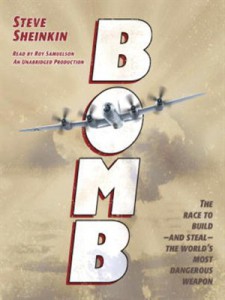 At the end of summer, my 12-year-old son and I road tripped to South Texas to visit friends. This involved a two-day drive down and a two-day drive back. To me, road trips mean audiobooks. Although my son is the stereotypical boy who doesn’t read, he has enjoyed audiobooks in the past; therefore I came prepared with three young adult possibilities, checked out from OverDrive and downloaded to my Kindle Fire: a dystopian thriller, a baseball mystery, and a nonfiction history book.
At the end of summer, my 12-year-old son and I road tripped to South Texas to visit friends. This involved a two-day drive down and a two-day drive back. To me, road trips mean audiobooks. Although my son is the stereotypical boy who doesn’t read, he has enjoyed audiobooks in the past; therefore I came prepared with three young adult possibilities, checked out from OverDrive and downloaded to my Kindle Fire: a dystopian thriller, a baseball mystery, and a nonfiction history book.
Listening to an audiobook held no appeal for him on the way down to Texas, but on the way back, the novelty of road tripping having completely worn off, he gave in to my suggestion that he select a title for us to listen to. Scanning the three I’d downloaded, it was really no contest: he immediately picked the nonfiction history book, Bomb: The Race to Build—and Steal—the World’s Most Dangerous Weapon, by Steve Sheinkin.
This is a great example of a nonfiction title that reads like fiction, and my son was rapt throughout the seven hour narration. The story jumps back and forth between Soviet agents recruiting young, initially unemployed U.S. chemist Harry Gold as a spy, Robert Oppenheimer’s efforts to assemble a team of scientists to build an atomic bomb at Los Alamos, and Norwegian resistance fighters’ intricate and ultimately successful plan to sabotage a heavy water plant in Norway in order to disrupt Nazi development of nuclear weapons.
The plot involving the Norwegian commandos was like something out of a James Bond or Mission Impossible movie, and my son sat bolt upright in his seat, the Kindle held to his ear so he wouldn’t miss a word. At one point he exclaimed “I could listen to this book forever!” Talk about music to a librarian mother’s ears! And when the team succeeded in infiltrating and blowing up the plant, he reacted with a fist pump and a “Yes!”
Learning about the espionage networks at work at the time was also fascinating. One of my favorite scenes involved two spies meeting up. Their handlers had given each spy half a Jell-O box cover. At first contact each man produced his half of the Jell-O box cover; when placed next to one another they matched up perfectly, letting each spy know that the other was legitimate.
Upon returning home I looked up author Steve Sheinkin and discovered that he’s penned additional nonfiction history books for young adults. And what do you know! My son had previously read and enjoyed two of them: The Notorious Benedict Arnold: A True Story of Adventure, Heroism & Treachery and King George: What Was His Problem?: The Whole Hilarious Story of the American Revolution. Given his 100% satisfaction rating to date, Steve Sheinkin is definitely an author who’ll stay on my radar as I continue to search for the right books for my particular reluctant reader!
Sheinkin, Steve. Bomb: The Race to Build–and Steal–The World’s Most Dangerous Weapon. Listening Library, 2013. (Listen to excerpt)
Friday Reads: Redeployment by Phil Klay
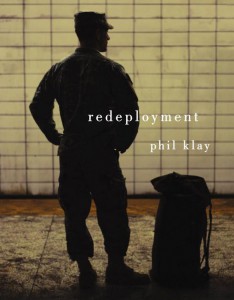 Phil Klay served in the Iraq War as a United States Marine and then earned his MFA degree. In this book, Klay’s short stories reflect the experiences of those who served in Iraq, both during deployments and upon returning home. He explores the harsh realities of war, but the sadness is tempered with humor, and I’m finding it very engrossing so far.
Phil Klay served in the Iraq War as a United States Marine and then earned his MFA degree. In this book, Klay’s short stories reflect the experiences of those who served in Iraq, both during deployments and upon returning home. He explores the harsh realities of war, but the sadness is tempered with humor, and I’m finding it very engrossing so far.
Klay, Phil. Redeployment. Penguin Press, 2014.
Friday Reads: We are Anonymous by Parmy Olson
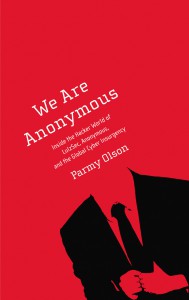 Ever wonder about the people and the technology behind such groups as Anonymous and LulzSec? Are these folks in it for the fun, or are they in it to change the world? Find out in the wonderfully entertaining book by Parmy Olson.
Ever wonder about the people and the technology behind such groups as Anonymous and LulzSec? Are these folks in it for the fun, or are they in it to change the world? Find out in the wonderfully entertaining book by Parmy Olson.
And, if you’re interested in earning CE credit for reading this title, be sure to check out Nebraska Learns 2.0 on September 1st as this title will be that month’s BookThing.
Olson, Parmy. We Are Anonymous: Inside the Hacker World of LulzSec, Anonymous and the Global Cyber Insurgency. Little Brown & Company, 2012
Friday Reads: Eat Pray, Love: one woman’s search for everything across Italy, India and Indonesia, by Elizabeth Gilbert
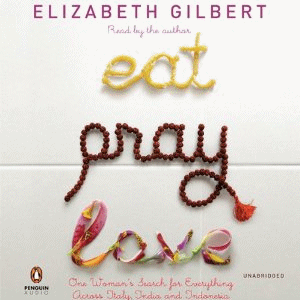 Gilbert’s story of her travels in Italy, India, and Indonesia searching for renewal and enlightenment originally came out in 2006 to acclaim (it was the New York Times Notable Book of the Year). Generally, tales of other people’s spiritual quests set my skepticism meter aquiver, and I didn’t read the book, or see the movie back when. But I’m an audiobook buff, and I was looking for something a little different, so I decided to try it. Gilbert reads the book herself, a real asset for such a personal, first person story. Her unaffected enthusiasm and her way with words are winning me over.
Gilbert’s story of her travels in Italy, India, and Indonesia searching for renewal and enlightenment originally came out in 2006 to acclaim (it was the New York Times Notable Book of the Year). Generally, tales of other people’s spiritual quests set my skepticism meter aquiver, and I didn’t read the book, or see the movie back when. But I’m an audiobook buff, and I was looking for something a little different, so I decided to try it. Gilbert reads the book herself, a real asset for such a personal, first person story. Her unaffected enthusiasm and her way with words are winning me over.
Gilbert, Elizabeth. Eat Pray, Love: one woman’s search for everything across Italy, India and Indonesia. Penguin Audio, 2006. CD.

